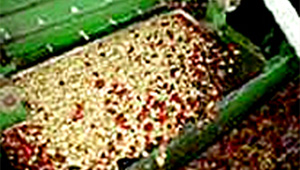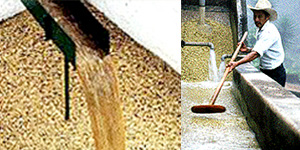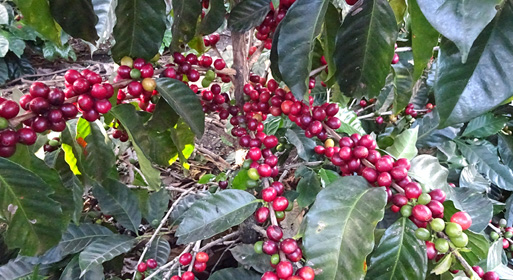Quality Assurance
IngredientsCoffee Beans
Major Producing Nations of Coffee Beans
Coffee beans are grown in more than 70 countries and regions across the world.
These coffee-producing nations are concentrated in an area known as the Coffee Belt, which lies between the latitudes 25 degrees north and 25 degrees south of the equator.
At Suntory Group, we mainly purchase coffee beans from Central and South America and Africa, but the approach to coffee bean quality assurance differs by nation.
As such, we regularly visit these producing nations to confirm that there are no issues with cultivation methods and quality assurance.

The Coffee Belt and major producing nations
Processing, Roasting, and Blending
There are two main processes required to make coffee beans, the main ingredient in our coffee: Processing, in which the beans are removed from the harvested coffee cherries, and roasting, in which the beans are heat treated.
Processing
There are largely two methods for removing coffee beans from the coffee cherries. Here we introduce the washing method. This process is undertaken at the producing region.
- Harvesting and Sorting
- Ripe red coffee cherries are individually harvested by hand over a period of just ten days. This method ensures consistent quality and makes it less likely that unripe and overripe cherries and foreign debris are included in the harvest.

- Removing the Flesh of the Cherry
- The sorted coffee cherries are then passed through a pulper to remove the skin and flesh.
At this stage, the beans are still covered in a layer known as parchment, hence the name parchment coffee.

- Removing the Mucilage and Washing
- fter being soaked in a tank of water for between 12 to 24 hours, the parchment coffee is washed through a water channel to remove the mucilage, which covers the parchment layer.
-
*Times differ depending on temperature, weather, and producing region.
-

- Drying
- The parchment coffee is then dried in the sun or in a machine dryer.

- Threshing
- Using a threshing machine, the parchment layer is removed from the parchment coffee to produce raw coffee beans.

- Sorting and Packing
- The raw coffee beans are then sorted to remove any contaminants before being packed into bags.
The beans can be sorted using a range of methods, including the use of wind power, screens, vibrations, and sensors, as well as of course by hand.

Roasting and Blending
These raw coffee beans are then transported to coffee roasting factories in Japan and heat treated (roasted). During this process, components in the raw beans undergo a chemical change, giving rise to various aromas and tastes. The roasted beans are then cooled in a refrigerator to prevent any further chemical reactions.
There are various roasting methods, too, including hot air roasting and direct flame roasting. The roasters and level of roast are changed depending on the characteristics of the raw coffee bean.
To ensure stable quality and unique flavors, coffee beans of different varieties, from different regions, and of different roasts are frequently mixed to create blends. At Suntory Group, we blend our beans after they have been roasted—rather than before—to create a diverse range of flavors.

Hot air roasting machine
-

Raw coffee beans
-

Roasted coffee beans
Guaranteeing Coffee Bean Quality (Our Initiatives in Guatemala)
Here we introduce the initiatives we are engaged in with Anacafe, the national coffee association of Guatemala.
Coffee beans are an agricultural product, the final quality of which is greatly impacted by the climate and natural features of the land in which they are produced, as well as the skills of those involved in their cultivation. As such, for many years since we first launched our Rainbow Mountain Blend, we have worked in close cooperation with Anacafe to guarantee both stable quality and quantity in the beans we use.
-

Harvesting work
-

Ready-to-harvest coffee plants
Every year in harvest season, we coordinate with our producing regions to discuss quality and share our ideas on ideal flavors. We then acquire only the necessary quantity of beans, and only those that have met strict flavor standards. Further, Suntory Group employees working on final products and ingredients always travel to these producing regions to check on cultivation progress, sorting arrangements, and other factors with their own eyes.
We are also improving product quality through direct communication with representatives of these producing regions.
-

Checking growth of coffee plants
-

Checking flavor standards

Harvested coffee cherries
The quality of the raw beans used in our Rainbow Mountain Blend are inspected a total of three times prior to roasting both in Guatemala and Japan. All of the quality checks are undertaken by coffee specialists.
The first quality check is undertaken by Anacafe and the local exporting company, and only beans that meet the standards fit for our Rainbow Mountain Blend are shipped.
Pre-export inspection in Guatemala (First check)
The second check, a preliminary inspection, is undertaken by Suntory Group following the arrival of beans in Japan.
Preliminary inspection following the beans’ arrival in Japan (Second check)
The third check is undertaken upon receipt of the beans at the roasting factory.
Only those that pass the checks are roasted for use in our Rainbow Mountain Blend.

Inspection upon receipt at the roasting factory (Third check)





